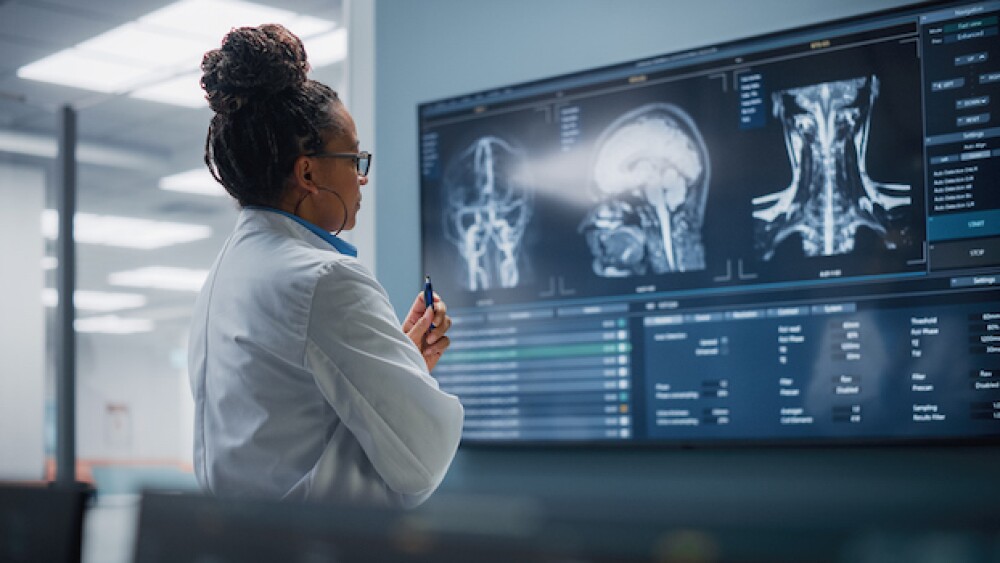Clinical results for experimental treatments in Alzheimer’s, ALS and more are expected over the coming months. BioSpace highlights a few of the more highly anticipated datasets.
Pictured: A neuroscientist looks at an MRI scan of a brain/courtesy of iStock
With the FDA hinting at regulatory flexibility for therapeutics targeting rare neurodegenerative diseases and those with a high unmet need, there’s a heightened sense of urgency for biopharma companies to secure pivotal data.
While analysts and other neuroscience watchers anticipate the upcoming decisions for Biogen’s tofersen and Eisai and Biogen’s Leqembi (lecanemab), key data are on the horizon in multiple sclerosis (MS), amyotrophic lateral sclerosis (ALS), Huntington’s disease and more. Below is a selection of some of the top readouts to watch for this year.
Alzheimer’s Disease
One of the most-anticipated readouts in the Alzheimer’s space is Eli Lilly’s donanemab. In January, the FDA rejected Lilly’s bid for accelerated approval of donanemab, an investigational anti-amyloid antibody. In its Complete Response Letter, the FDA requested unblinded, controlled safety data from a Phase III confirmatory trial. Data from this trial, TRAILBLAZER-ALZ, are expected early in the second quarter of this year.
The regulator also requested data from at least 100 patients dosed continuously with donanemab for a minimum of 12 months. This was not achieved with the Phase II study due to Lilly’s treat-to-clear model, which allowed patients to stop treatment when their amyloid plaques had been cleared to a predefined level.
In January, Anne White, executive vice president and president of Lilly Neuroscience, said the company anticipates TRAILBLAZER-ALZ will confirm the benefit and safety profile observed in the Phase II trial.
Huntington’s Disease
The past three years have seen several swings—and several misses—in the Huntington’s space. This list includes two more swings.
The first is Prilenia Therapeutics’ pridopidine. On March 28, Prilenia announced it had completed its Phase III PROOF-HD study, with topline results expected in early Q2, 2023.
Pridopidine is a highly selective investigational agonist of sigma-1 receptor (S1R), a protein highly expressed in the brain that regulates several cellular mechanisms common to neurodegenerative diseases. Activation of S1R stimulates multiple cellular pathways essential to neuronal function and survival, according to Prilenia.
PROOF-HD is the only late-stage Huntington’s study targeting clinical progression. If the results are positive, Prilenia intends to submit for regulatory approval in both the U.S. and E.U.
The second swing belongs to Amsterdam-based uniQure, which is developing the first-ever adeno-associated virus (AAV) gene therapy for Huntington’s. AMT-130 is currently in Phase I/II trials in the U.S. with a clinical update expected in Q2, 2023.
In August 2022, uniQure paused enrollment in the higher dose cohort of the European Phase Ib/II trial due to unexpected severe adverse reactions in three trial participants. uniQure announced in November that enrollment would resume following a “comprehensive” review of all available safety, biomarker and imaging data in the trial.
AMT-130 leverages uniQure’s proprietary platform to introduce an AAV to the brain. The AAV carries a microRNA to reduce the production of a toxic protein known as mutant HTT (mHTT), the bad form of the huntingtin protein coded for by the HTT gene.
In June 2022, uniQure reported that six patients treated with low dose AMT-130 showed a 53.8% mean reduction of mHTT in the cerebral spinal fluid after 12 months.
“We know that the biomarkers are moving,” Ricardo Dolmetsch, president of R&D at uniQure, told BioSpace in November. “We know that we are reducing huntingtin . . . and we know that the main marker of neuronal damage, which is neurofilament light chain, is trending downwards.”
Rett Syndrome
March 2023 saw the approval of the first therapy for Rett Syndrome, a multisystem neurodevelopmental disorder affecting primarily female children, when the FDA green-lit Acadia Pharmaceuticals’ Daybue (trofinetide).
Hot on Acadia’s heels, Anavex Life Sciences is advancing ANAVEX®2-73 (blarcamesine) for Rett. The New York–based biopharma anticipates topline data from a Phase II/III trial in pediatric patients in the second half of 2023. In February, Anavex reported that the trial had exceeded its enrollment target.
Anavex previously reported positive data from the Phase III study of ANAVEX®2-73 in adult female patients. The drug met all primary and secondary efficacy and safety endpoints, showing consistent improvements on the Rett Syndrome Behavior Questionnaire and other metrics.
Like pridopidine, ANAVEX®2-73 activates S1R. According to Anavex, data suggest that activation of S1R (also known as SIGMAR1) restores homeostatic function within the body and neural cell balance. ANAVEX®2-73 holds Fast Track, Rare Pediatric Disease and Orphan Drug designations from the FDA.
ALS
The ALS space is experiencing a renaissance of sorts, with the September 2022 approval of Amylyx’s Relyvrio (AMX0035) and a March 2022 advisory committee signaling its support for Biogen’s tofersen.
Hoping to get in on the momentum is Seelos Therapeutics, which is testing SLS-005 (trehalose) in patients with familial and sporadic ALS. In February 2023, the biopharma announced it had completed enrollment of its Phase II/III trial. Seelos anticipates topline data in the second half of 2023.
The double-blinded and placebo-controlled trial consists of 160 patients randomized 3:1 (drug: placebo). The trial’s primary endpoint is change from baseline on the Revised Amyotrophic Lateral Sclerosis Functional Rating Scale at 24 weeks. Secondary endpoints include change from baseline in slow vital capacity, quality of life measurements and muscle strength.
SLS-005 is believed to stabilize proteins and trigger autophagy through activation of transcription factor EB (TFEB), a primary factor in lysosomal and autophagy gene expression.
The trehalose trial is being conducted on the HEALEY ALS platform, an academic effort to test multiple ALS candidates in parallel in an effort to expedite research.
Multiple Sclerosis
In 2022, Harvard Professor Alberto Ascherio published results of a longitudinal study that cemented previous research regarding the role of the Epstein-Barr virus (EBV) in MS. It’s a hypothesis Atara Biotherapeutics is now pursuing.
Atara is developing ATA188, an allogeneic T-cell immunotherapy that targets EBV-infected B-cells and plasma cells in the central nervous system—cells that are thought to trigger autoimmune responses. ATA188 is intended to treat progressive MS, for which there is a high unmet need.
Atara expects final data from the Phase II EMBOLD trial in October 2023.
In February 2022, Atara President and CEO Pascal Touchon called the readout a “key catalyst that could progress ATA188 towards becoming the first ever targeted and transformative therapy in multiple sclerosis following the landmark scientific discovery of EBV as the leading trigger of MS.”
Heather McKenzie is a senior editor at BioSpace, focusing on neuroscience, oncology and gene therapy. You can reach her at heather.mckenzie@biospace.com. Follow her on LinkedIn and Twitter: @chicat08.






